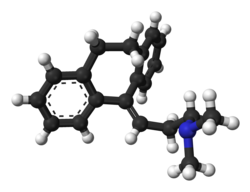User:Mr. Ibrahem/Amitriptyline
 | |
 | |
| Clinical data | |
|---|---|
| Pronunciation | /ˌæmɪˈtrɪptɪliːn/[1] |
| Trade names | Elavil, others |
| Other names | Amitryptyline; Amytriptyline; Amitryptiline; Amitriptiline; MK-230; N-750; Ro 4-1575 |
| AHFS/Drugs.com | Monograph |
| MedlinePlus | a682388 |
| License data |
|
| Pregnancy category |
|
| Routes of administration | By mouth, intramuscular injection |
| Drug class | Tricyclic antidepressant (TCA) |
| Legal status | |
| Legal status | |
| Pharmacokinetic data | |
| Bioavailability | 30–60% |
| Protein binding | 96%[2] |
| Metabolism | Liver[2] (CYP2D6, CYP2C19) |
| Metabolites | nortriptyline |
| Elimination half-life | 10–50 hours[2] |
| Excretion | Urine[2] |
| Identifiers | |
| |
| Chemical and physical data | |
| Formula | C20H23N |
| Molar mass | 277.411 g·mol−1 |
| 3D model (JSmol) | |
| Melting point | 188 °C (370 °F) |
| |
| |
| (verify) | |
Amitriptyline, sold under the brand name Elavil among others, is a medicine primarily used to treat a number of mental illnesses.[2] These include major depressive disorder and anxiety disorders, and less commonly attention deficit hyperactivity disorder (ADHD) and bipolar disorder.[2][5] Other uses include prevention of migraines, treatment of neuropathic pain such as fibromyalgia and postherpetic neuralgia, and less commonly insomnia.[2][6] It is in the tricyclic antidepressant (TCA) class and its exact mechanism of action is unclear.[2] Amitriptyline is taken by mouth.[2]
Common side effects include blurred vision, dry mouth, low blood pressure on standing, sleepiness, and constipation.[2] Serious side effects may include seizures, an increased risk of suicide in those less than 25 years of age, urinary retention, glaucoma, and a number of heart issues.[2] It should not be taken with MAO inhibitors or the medication cisapride.[2] Amitriptyline may cause problems if taken during pregnancy.[2][7] Use during breastfeeding appears to be relatively safe.[8]
Amitriptyline was discovered in 1960[9] and approved by the US Food and Drug Administration (FDA) in 1961.[10] It is on the World Health Organization's List of Essential Medicines.[11] It is available as a generic medication.[2] The wholesale cost in the developing world as of 2014[update] was between 0.01 and US$0.04 per dose.[12] In the United States, it costs about US$0.20 per dose.[2] In 2017, it was the 87th most commonly prescribed medication in the United States, with more than nine million prescriptions.[13][14]
References
[edit]- ^ Oxford Dictionary: Definition of amitriptyline (British & World English) Archived 14 July 2014 at the Wayback Machine
- ^ a b c d e f g h i j k l m n o "Amitriptyline Hydrochloride". The American Society of Health-System Pharmacists. Archived from the original on 24 September 2014. Retrieved 25 September 2014.
- ^ a b Cite error: The named reference
MSF2020was invoked but never defined (see the help page). - ^ "WHOCC - ATC/DDD Index". www.whocc.no. Archived from the original on 21 October 2020. Retrieved 22 September 2020.
- ^ Leucht C, Huhn M, Leucht S (December 2012). "Amitriptyline versus placebo for major depressive disorder". The Cochrane Database of Systematic Reviews. 12: CD009138. doi:10.1002/14651858.CD009138.pub2. PMID 23235671.
- ^ Moore RA, Derry S, Aldington D, Cole P, Wiffen PJ (July 2015). "Amitriptyline for neuropathic pain in adults". The Cochrane Database of Systematic Reviews. 7 (7): CD008242. doi:10.1002/14651858.CD008242.pub3. PMC 6447238. PMID 26146793.
- ^ "Prescribing medicines in pregnancy database". Australian Government. 3 March 2014. Archived from the original on 8 April 2014. Retrieved 22 April 2014.
- ^ "Amitriptyline Levels and Effects while Breastfeeding". drugs.com. 8 September 2014. Archived from the original on 24 September 2014. Retrieved 25 September 2014.
- ^ Sneader, Walter (2005). Drug Discovery a History. Chichester: John Wiley & Sons. p. 414. ISBN 9780470015520. Archived from the original on 8 September 2017.
- ^ Fangmann P, Assion HJ, Juckel G, González CA, López-Muñoz F (February 2008). "Half a century of antidepressant drugs: on the clinical introduction of monoamine oxidase inhibitors, tricyclics, and tetracyclics. Part II: tricyclics and tetracyclics". Journal of Clinical Psychopharmacology. 28 (1): 1–4. doi:10.1097/jcp.0b013e3181627b60. PMID 18204333. S2CID 31018835.
- ^ World Health Organization (2019). World Health Organization model list of essential medicines: 21st list 2019. Geneva: World Health Organization. hdl:10665/325771. WHO/MVP/EMP/IAU/2019.06. License: CC BY-NC-SA 3.0 IGO.
- ^ "Amitriptyline". International Drug Price Indicator Guide. Archived from the original on 30 March 2017. Retrieved 2 December 2015.
- ^ "The Top 300 of 2020". ClinCalc. Archived from the original on 18 March 2020. Retrieved 11 April 2020.
- ^ "Amitriptyline - Drug Usage Statistics". ClinCalc. Archived from the original on 30 April 2017. Retrieved 11 April 2020.
